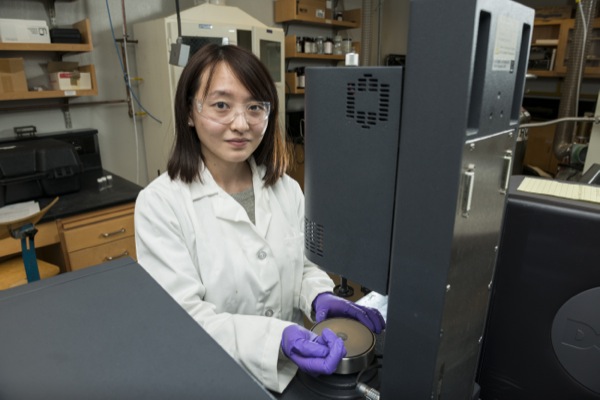Research aims to improve personal care, medicinal products
8:30 a.m., Feb. 12, 2013–For those who have wondered why shampoo moisturizes hair rather than drying it out, or how antidandruff shampoo works, it is due to a process known as coacervation.
The chemicals or organic materials that treat dandruff or moisturize skin are packaged with polymer-surfactant complexes in what is known as a coacervate. Coacervates then release the materials, such as oil droplets that moisturize hair, when exposed to an external compound such as water.
“Most people don’t realize that when you rub shampoo and water in your hands, coacervation is occurring,” explains Dongcui Li, a fourth year graduate student in the University of Delaware’s Department of Chemical and Biomolecular Engineering.
Li studies how these coacervates form and bind to target surfaces in order to find a rapid molecular approach to the rational design of engineering complex polymer-surfactant materials found in certain solutions. “By learning more about the molecular interactions that govern the selectivity of the coacervation process, we can make the delivery process more precise and the product more effective,” she says.
In the case of antidandruff shampoo, antibacterial agents that eliminate dandruff are activated when the coacervate comes in contact with warm water, and delivered to the scalp in a targeted way.
Coacervates can also be important mechanisms for drug delivery. For example, many cold medicines treat multiple symptoms and therefore need to target several different parts of the body to provide relief.
“Unlocking how the chemical structure combines to yield the desired mechanical and thermodynamic properties of the coacervate could open new doors for creating a wide variety of consumer products and biomedicines,” explained Norman Wagner, Alvin B and Julie O Stiles Professor of Chemical and Biomolecular Engineering and Li’s faculty adviser.
Li will present her doctoral work at the Excellence in Graduate Polymer Research Symposium of the American Chemical Society (ACS) national meeting to be held April 7-11 in New Orleans. She received an Excellence in Polymer Graduate Research award from the ACS Polymer Chemistry Division (POLY) to attend the conference.
Article by Sarah E. Meadows
Photo by Evan Krape

